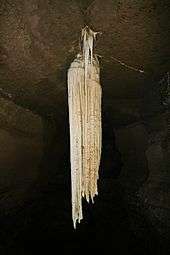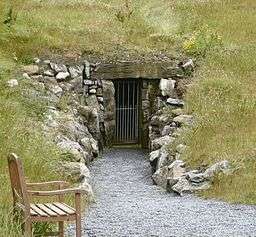Doolin Cave
| Pol an Ionain | |
|---|---|
|
Entrance to Pol an Ionain | |
| Location | Doolin, Clare, Ireland |
| Length | c. 600m |
| Discovery | 1952 |
| Geology | Limestone |
| Entrances | 1 |
| Access | Show cave |
| Translation | Ivy Cliff Cave |
| Pronunciation | [Powl on Un-awn] |
Pol an Ionain (or Poll-an-Ionain) is a limestone cave near Doolin in County Clare, Ireland, on the western edge of The Burren. The name is the anglicised version of the Irish name Poll an Eidhneáin, which is said to translate into "Ivy Cliff Cave".[1] The cave attracted some controversy due to its development and marketing as a show cave in the early 21st century.[1][2] It is now open to the public as Doolin Cave.
The Great Stalactite

The cave's most notable feature is the Great Stalactite.[3] This is one of the world's longest known free-hanging stalactites, reported to be 7.3 m (24 ft) in length.[4] This figure is a matter of some confusion, however, as it is also variously described as being 11 m, 6.2 m and 6.54 m.[5] It is the longest known free-hanging stalactite in Europe, the three largest in the world being located in two caves in Mexico,[6] and one in Jeita Grotto, Lebanon.[5]
History
The cave was discovered in 1952 by J. M. Dickenson and Brian Varley of Craven Pothole Club, an English caving club based in the Yorkshire Dales.[1] The cave quickly became a classic caving trip for visiting cavers. Entry was arduous, requiring a long, difficult crawl.
In 1990, the land on which the cave is located was purchased by John and Helen Browne.[3] The couple immediately embarked on an effort to develop the cave as a show cave. This provoked a reaction from the Speleological Union of Ireland who feared the 30-metre (98 ft) shaft that would have to be blasted to access the cave would damage the stalactite. They also objected to the fact that the caving trip would be lost to cavers and that the cave was a short artificial trip with only one feature. After an extended period of court proceedings, financing and development, the cave was opened to the public as a show cave in 2006, subject to the conditions of not having a visitor centre on site and restricting visitor numbers. No blasting was allowed to construct the entrance shaft. The developers instead used as system whereby a hole was drilled and an air expander placed in the hole to break the rock.
In 2010, a visitors' centre and cafe opened on the site.
The development of Pol an Ionain has been criticised for being environmentally damaging and for being devoid of any features beside the Great Stalactite.[7][8]
In spite of this, Doolin Cave has twice received Gold Standard from Ecotourism Ireland, in 2013 and 2015. Doolin Cave is also a member of the Burren Ecotourism Network.
Businesses who are members of the Burren Ecotourism Network (B.E.N.) adhere to the Burren and Cliffs of Moher Geopark [9] Code of Practice. B.E.N.is committed to the promotion of responsible tourism that conserves the environment and improves the well being of local people.
References
- 1 2 3 "Poll an Ionain". Doolin, County Clare, Ireland. Retrieved 2008-06-28.
- ↑ Duckeck, Jochen. "Doolin Cave – Pol an Ionain". Retrieved 2010-10-09.
- 1 2 "The Great Stalactite". Doolin Cave. Retrieved 2008-06-28.
- ↑ "The Burren: Caves in the Burren". Clare County Library. Retrieved 2008-06-28.
- 1 2 Duckeck, Jochen. "Caves With The Longest Stalactite". Retrieved 2010-10-09.
- ↑ Bunnell, Dave. "The World's Largest Cave Formations". Retrieved 2010-10-09.
- ↑ "Doolin cave dispute surfaces again". The Irish Times. 3 Mar 2009. Retrieved 2010-10-09.
- ↑ Deegan, Gordon (2 Feb 1999). "Plans to develop cave get go-ahead". Irish Examiner. Retrieved 2010-10-09.
- ↑ "Burren and Cliffs of Moher Geopark | Ireland". www.burrengeopark.ie. Retrieved 2015-10-12.
Further reading
- Mullan, Graham, ed. (2003). The Caves of County Clare & South Galway. University of Bristol Spelæological Society.
Coordinates: 53°02′31″N 9°20′42″W / 53.04194°N 9.34500°W
